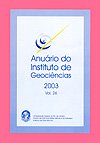Bacterial enzymatic activity and bioavailability of heavy metals in sediments from Boa Viagem Beach (Guanabara Bay)
DOI:
https://doi.org/10.11137/2003_0_60-68Abstract
This study focuses on the quality of the organic matter that reaches the sediment from Boa Viagem Beach and through the evaluation of the total bacterial count, the electron transport system activity (ETSA), the esterase activity (EST), as well as the protein and the organic matter contents. Seasonal variations of organic matter, protein content and the number of bacteria were particularly notable in the summer. ETSA reached a maximum of 7.48 µl O2 h-1 g-1 in the summer. EST activity presented a different pattern once it reached a maximum of 0.17 µg fluorescein h-1 g-1 in the winter. The temporal variation of ETSA and EST activity indicated that biopolymers predominated in the winter, and oligomers or monomers predominated in the summer. These results suggest that organic carbon turnover is more likely to be controlled by organic matter quality. The heavy metals concentrations, especially for Cu, Zn, Ni and Cr, indicated absence of the inhibition of dehydrogenase activity, and they are not bioavailable in the EC50 valuesDownloads
Download data is not yet available.
Downloads
Published
2003-01-01
How to Cite
Crapez, M., Baptista Neto, J. A. and Bispo, M. G. S. (2003) “Bacterial enzymatic activity and bioavailability of heavy metals in sediments from Boa Viagem Beach (Guanabara Bay)”, Anuário do Instituto de Geociências. Rio de Janeiro, BR, 26, pp. 60–68. doi: 10.11137/2003_0_60-68.
Issue
Section
Article
License
This journal is licensed under a Creative Commons — Attribution 4.0 International — CC BY 4.0, which permits use, distribution and reproduction in any medium, provided the original work is properly cited.















